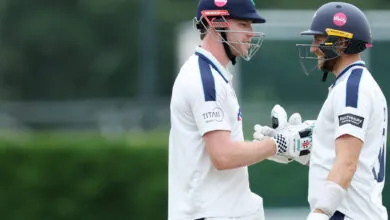Half a dozen future county cricketers were born in 1871, including two who had outstanding careers, and Paul Dyson looks back at their time in the game.
The first future Yorkshire cricketer to see the light of day in 1871 was one of its greatest-ever bowlers. Schofield Haigh was born on March 19th at Berry Brow, near Huddersfield. As he has been previously profiled in these columns, there follows only a brief profile. An outstanding swing bowler, he played for the county from 1895 to 1913 and his tally of 1,876 wickets has been bettered by only two other bowlers – his contemporaries George Hirst and Wilfred Rhodes. No mean batsman, he is one of only four Yorkshire players to score over 10,000 runs as well as take more than 2,000 wickets in a full first-class career. He completed the double in 1904, received a well-deserved benefit in 1909 and took a career-best nine for 25 against Gloucestershire at Headingley at the age of 41 in the season prior to his retirement. A great bowler.
There was then a five-month gap before the next birth but four came along in the space of just 15 days. The first of these was Joe Mounsey. He was born on August 31st in Heeley, Sheffield and played for both Sheffield Heeley and Sheffield United. He played for Yorkshire in seven of the seasons in the 1890s and played a part in the county’s first two title-winning campaigns. However, apart from in 1894 he was not a regular member of the team, despite being awarded his county cap, and as a middle order batsman never made a century.
Mounsey always worked hard at his game, played solidly at times, and was given several opportunities but in his 92 matches made only seven half-centuries; four of these came in 1894 when he played in 27 matches. He ended his county career with 1,939 runs and in 1899 became coach at Charterhouse School. He remained at the school for an impressive 48 years, coaching for 28 then fulfilling the role of groundsman for 11 before almost seeing out his days as an umpire. He remained in the area and died near Godalming in Surrey in 1949. Although he did not achieve a great deal with Yorkshire he was obviously devoted to the game.
Three days later, in a completely different part of the county, appeared William Ringrose. He was born at Ganton near Scarborough but, like Mounsey, also played for Sheffield United. Also, like Mounsey, he received a cap but never truly established himself in the team as a regular. He made his debut in 1901 at the age of 29 as a fast-medium bowler and had his best season in 1905 when Yorkshire took the title and he took 73 wickets in 20 matches. In that same season he took nine for 76 against the touring Australians at Bradford and also had his best figures in a county match when he had figures of seven for 51 against Leicestershire at Sheffield.
Ringrose’s club career also took him to Liverpool and Oxton and later, after his county career had concluded, he had seven seasons with Forfarshire. While in Scotland he represented the country in four first-class matches including three against Test-playing tourists. His final season with Yorkshire of 1906 was marred by ill-health and he ended his time with the county having taken 155 wickets in 57 matches. In 1923 he returned to the White Rose county and served as its scorer for 17 seasons until the outbreak of World War II. He died in 1943 in Manston, Leeds just 12 days after marking his 72nd birthday.
The other great-to-be from 1871 was a certain George Hirst. He was born in Kirkheaton, Huddersfield on September 7th. As with Haigh, he has also been previously profiled in these columns so, again, there follows just a brief summary of his great achievements. He made his debut for Yorkshire at the age of 19 and retired thirty years later although he returned for one match in 1929. With Rhodes, the pair are regarded as the two best all-rounders ever to play county cricket for any team and the figures bear this out. In 1906 Hirst scored two centuries and took two five-fors all in the same match against Somerset at Bath. He ended the season with another unique double – 2,000 runs and 200 wickets in the same season. Two years earlier he had received a benefit and in 1921 was also granted a testimonial. His county career produced, in 717 matches, 32,024 runs and 2,481 wickets. Astonishing figures. He died in Lindley, Huddersfield in 1954 at the age of 82.




